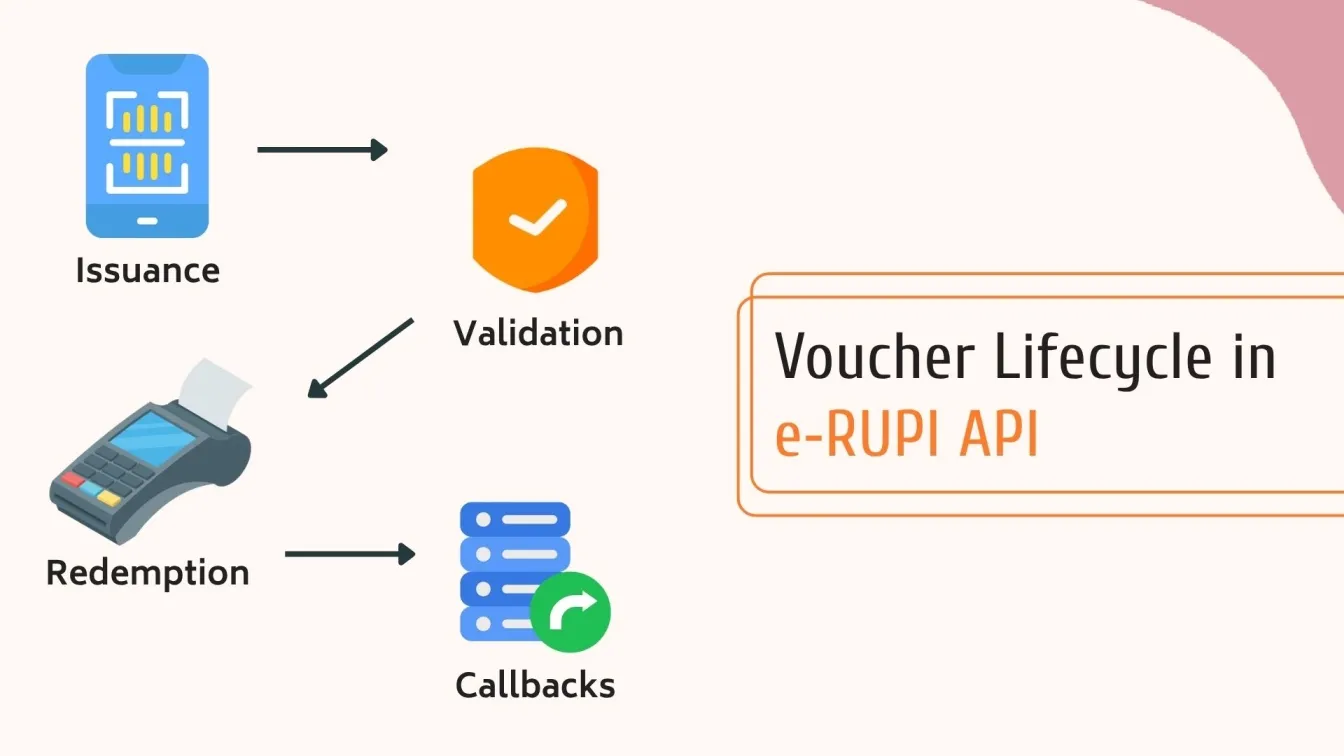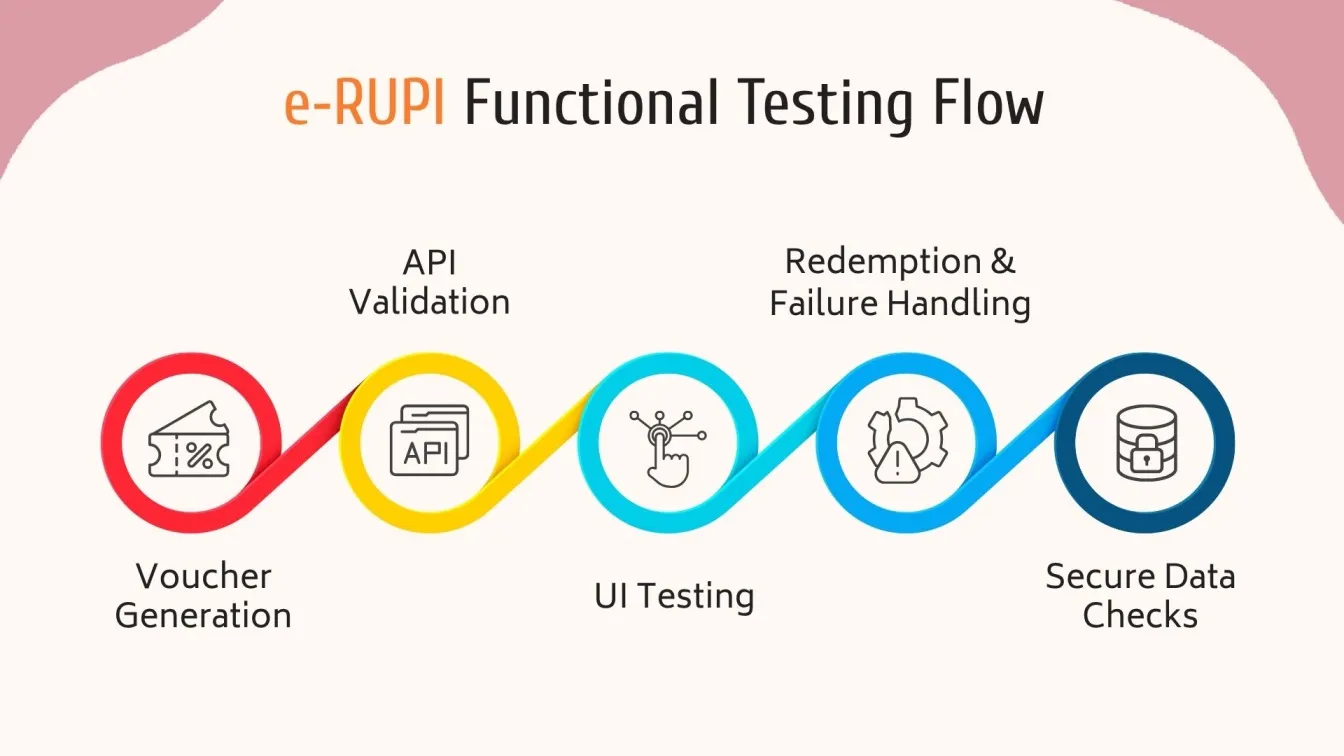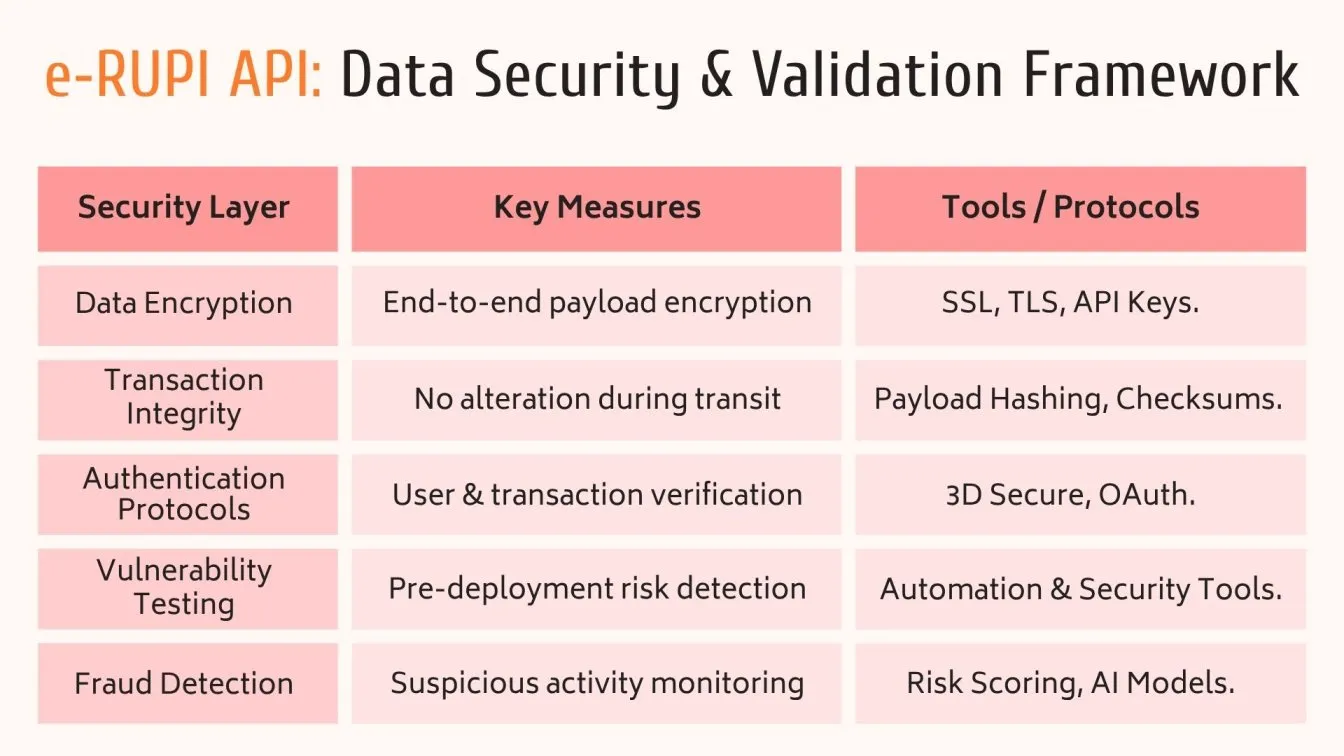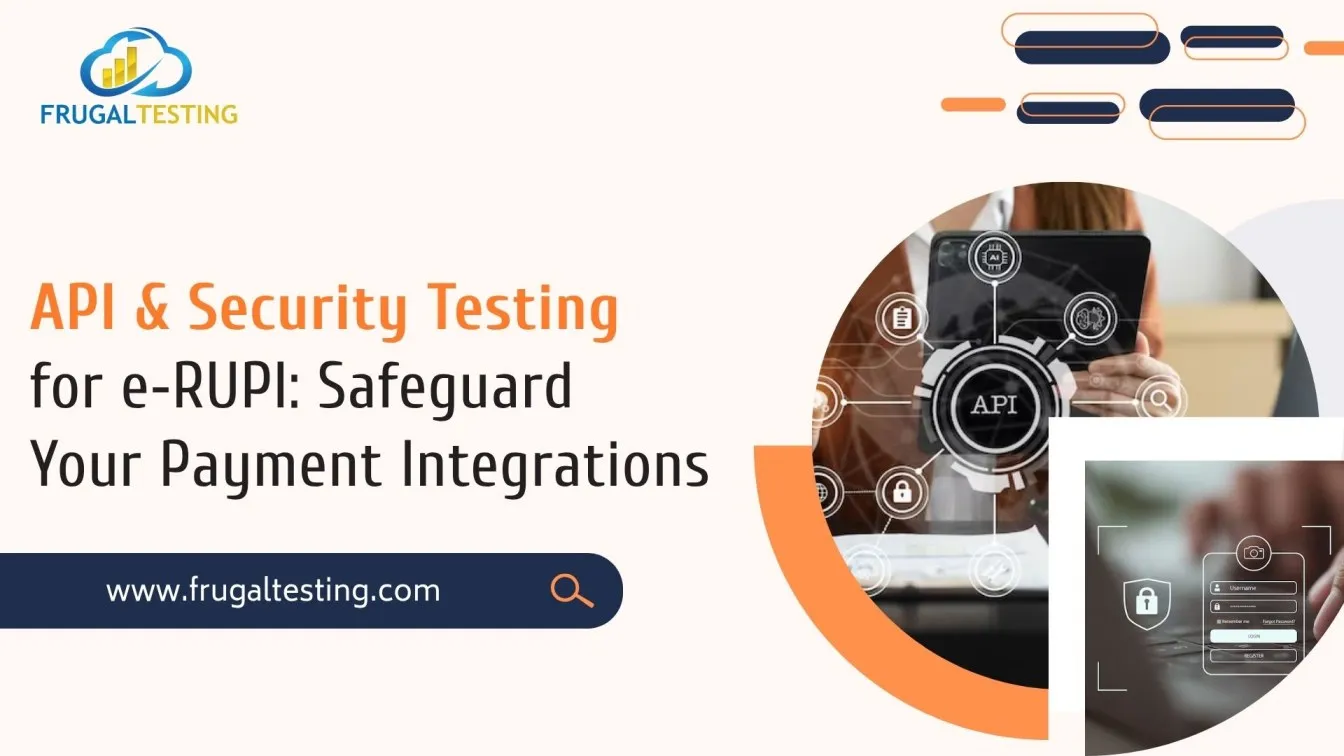Secure API testing is essential for robust e‑RUPI integrations in the fintech landscape. By combining API security testing, performance testing, and api load testing, organizations ensure that every voucher transaction is reliable and tamper-resistant.
Use Postman API testing in conjunction with load testing tools like k6 load testing or JMeter load testing to validate REST API and SOAP API endpoints under real-world conditions. Integrate free API for testing environments and trusted api testing tools to explore vulnerabilities, enforce web API security, and simulate security penetration testing scenarios.
Fintech companies must also prioritize security vulnerability testing and continuous regression testing in software testing to comply with the RBI and PCI-DSS standards. This multi-layered strategy establishes a secure and high-performance foundation for e-RUPI fintech operations.

✨ e‑RUPI API & Security Testing Overview
📌 Purpose: Understand how secure API testing strengthens e‑RUPI payment integrations in fintech.
📌 Key Focus: Learn core concepts like authentication, encryption, and API Security OWASP practices.
📌 Tools Covered: Explore tools like Postman, JMeter, and K6 for testing and compliance.
📌 Security Insights: Discover how tokenization, 3D Secure, and fraud prevention protect transactions.
📌 Takeaway: Gain clarity on building secure, scalable, and RBI-compliant e‑RUPI payment systems.
Understanding the e‑RUPI API: Role, Architecture & Key Endpoints
The e‑RUPI API plays a crucial role in streamlining digital voucher payments, especially within fintech platforms. It ensures secure processing of transactions, protection of customer payment information, and smooth integration with various systems through structured endpoints.

- Role of e‑RUPI API: The API manages the end-to-end flow of voucher distribution and usage. It secures sensitive data, such as UPI IDs, card details, and transaction information, using data encryption, API keys, and fraud detection systems.
- API Architecture: It supports both REST API and SOAP API interactions and is built on a robust API-driven foundation. The system utilizes encryption protocols, tokenization, rate limits, and OpenAPI specifications for safe and scalable operations.
- Key Endpoints: Core endpoints cover voucher issuance, validation, redemption, and callbacks. Each is tested using API testing tools and performance testing tools such as Postman, JMeter, and k6 to ensure accuracy and stability.
Setup & Test Environment for e‑RUPI Integration
Setting up a secure and reliable environment for e‑RUPI integration is essential for fintech applications. Follow these steps to ensure success:

1. Set Up Sandbox Access: Use sandbox credentials and API keys from the provider to begin secure integration.
2. Review API Documentation: Understand the REST API or SOAP API structure using detailed OpenAPI specifications.
3. Configure Testing Tools: Use Postman API testing for endpoint validation and JMeter load testing or k6 load testing for performance.
4. Implement Security Layers: Apply SSL encryption, TLS encryption, and tokenization to protect customer data and transaction details.
5. Perform Functional & Regression Testing: Test with real-world scenarios using software testing services and regression testing to catch early issues.
6. Monitor API Response & Behavior: Analyze API response, rate limits, and fraud detection systems for stable operations.
Functional Testing of e‑RUPI Payment Flows
Functional testing of e‑RUPI payment flows ensures each step of the transaction process works as intended across various fintech applications. It includes testing voucher generation, redemption, and failure scenarios using real-world data and predefined test cases. Tools like automated test cases and web automation testing frameworks help simulate user behavior, validate API response, and maintain accuracy.

By incorporating machine learning, transaction patterns can be further examined for irregularities. Testing encompasses both application programming interfaces (APIs) and user interfaces, ensuring seamless integration across cloud services.
Emphasis is placed on verifying API inventory, proper execution of rate limits, and securing customer payment information. Comprehensive functional validation lays the foundation for high-quality releases, while aligning with top software testing services and improving trust in digital payment workflows.
Authentication & Authorization Testing for e‑RUPI API Integrations
Authentication and authorization testing are crucial for securing e-RUPI API integrations and protecting sensitive customer data. Follow these key steps:
1. Validate User Identity Mechanisms: Test biometric verification, OTPs, and credentials for secure access to application programming interfaces.
2. Review Token Management: Verify secure generation and expiration of access tokens, especially for hosted payment gateway systems.
3. Simulate Unauthorized Access: Use security penetration testing and security vulnerability testing to ensure restricted endpoints are inaccessible.
4. Check Role-Based Access Controls (RBAC): Ensure only authorized roles can redeem vouchers or view transaction details.
5. Inspect API Header Authorization: Test API testing tools like Postman to validate headers and authentication flows.
6. Monitor Session Behavior: Analyze user behavior, session timeouts, and API response under different permission levels.
Data Encryption & Integrity Validation for e‑RUPI API Transactions
Securing e‑RUPI API transactions requires robust data encryption and strict integrity validation measures. Using SSL certificates, TLS encryption, and 3D Secure protocols helps protect customer payment information and card details during transmission. Software security testing ensures that API keys, transaction details, and UPI IDs are encrypted end-to-end and remain unaltered.

Implementing fraud checks and risk scoring mechanisms further strengthens data protection. Testing with tools such as automation testing tools and security testing services enables the early detection of vulnerabilities in the API-driven architecture.
Validating encrypted payloads and monitoring API response under different scenarios ensures consistent data integrity. These best practices enable secure, compliant fintech software environments and build user trust in digital payment systems.
Security Testing for e‑RUPI API Vulnerabilities and Threat Scenarios
Securing e‑RUPI APIs is essential in the fintech space to protect payment integrations, prevent data breaches, and ensure reliable digital transactions. Through rigorous API security testing and security vulnerability testing, developers can uncover hidden flaws and improve resilience against evolving risks in the API Economy.
Common API Vulnerabilities:
- Broken authentication & exposure of API keys
- Lack of tokenization and improper 3D Secure authentication
- Poor rate limit enforcement, enabling zombie APIs
- Insecure SOAP API or REST API endpoint configurations
- Absence of encryption and TLS protection for sensitive data

- Threat Scenarios to Simulate:
- Unrestricted Resource Consumption attacks via load testing tools
- Credential stuffing and token hijacking on mobile apps
- DDoS via tools like JMeter load testing or k6 load testing
- Misuse of stolen UPI ID or payment data across payment networks
Using trusted API testing tools like Postman and adhering to security protocols ensures safe e‑RUPI operations.
Performance and Load Testing for Payment APIs
To ensure seamless transactions and scalable infrastructure, Performance Testing and Load Testing are essential for Payment APIs, especially in fintech applications. These tests help prevent lags, failures, and revenue losses during high traffic or complex operations.
Performance Testing:
Evaluate the response time, transaction flow, and throughput of REST APIs and SOAP APIs using tools like Gatling Performance Testing and website performance testing. This identifies slow endpoints and performance bottlenecks. Testing across different mobile apps and cloud services ensures real-world consistency.
Load Testing:
Simulate heavy usage scenarios using K6 load testing, JMeter load testing, and other load testing tools to assess the API’s behavior under pressure. This helps detect issues such as Unrestricted Resource Consumption and system crashes. Monitoring application programming interfaces ensures stability and preparedness for peak periods.
Both methods support robust software testing services, ensuring secure, efficient, and scalable digital payment ecosystems.
Conclusion: Ensuring Secure, Reliable e‑RUPI Operations
Ensuring secure and reliable e‑RUPI operations demands a layered approach with software testing, regression testing in software testing, and security penetration testing to prevent vulnerabilities and ensure consistent payment integrations. Verifying API response under varied conditions strengthens trust across fintech companies and payment networks.
By integrating software security testing and leveraging artificial intelligence, biometric verification, and user behavior analysis, fintech firms can detect threats like API Keys exposure, UPI ID misuse, and Internet of Things risks. Adopting secure OpenAPI specifications is key for compliance and scalability.
Robust protection comes from maintaining accurate API documentation, tracking API inventory, and applying safeguards like SSL certificates, TLS encryption, and risk scoring. Ensuring adherence to security standards across insurance carriers and contactless options improves long-term resilience. Ultimately, implementing continuous security vulnerability testing and aligning with API Security OWASP practices will support efficient, scalable, and compliant digital payment operations.
Frugal Testing offers expert functional testing services and load testing services for secure e‑RUPI API setups. As a top software testing service provider, they specialize in SaaS application testing and QA testing services for enterprises to ensure reliable payment performance.api attack
People Also Ask
1. What is the difference between application security and API security?
Application security protects the entire software system, while API security focuses specifically on safeguarding data, endpoints, and access in application programming interfaces.
2. How many types of API authentication are there?
There are several types, including Basic Auth, API Keys, OAuth, JWT, and biometric authentication, each offering different levels of API security and access control.
3. Who is responsible for API security in integrated systems like e‑RUPI?
API security in systems like e‑RUPI is a shared responsibility among development teams, QA testers, security analysts, and integration partners.
4. What are common examples of API attacks on payment integrations?
Common API attacks include injection flaws, broken authentication, rate limit abuse, zombie APIs, and token hijacking in fintech payment systems.
5. How do you simulate DDoS or brute-force attacks in API security testing?
Security testing tools like JMeter and K6 are used to simulate DDoS or brute-force attacks by generating high traffic or repeated login attempts.





%201.webp)

